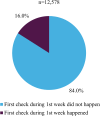Factors influencing early postnatal care use among postpartum women in Afghanistan
- PMID: 39732860
- PMCID: PMC11682322
- DOI: 10.1038/s41598-024-82750-8
Factors influencing early postnatal care use among postpartum women in Afghanistan
Abstract
Using postnatal care (PNC) within the first week following childbirth is crucial, as both the mother and her baby are particularly vulnerable to infections and mortality during this period. In this study, we examined the factors associated with early postnatal care (EPNC) use in Afghanistan. We used data from the multiple indicator cluster survey (MICS) 2022-2023. The study population was ever-married women who delivered a live child during their recent pregnancy within the 2 years preceding MICS 2022-23. The outcome was EPNC and defined as the first check of the mother within the first week of delivery. A binary logistic regression was used, and odds ratio (OR) and 95% CI were obtained. Out of 12,578 women, 16.0% received EPNC. EPNC was lower in women who delivered at home [AOR 0.35 (95% CI 0.28-0.44)] compared with women who delivered at public clinics. EPNC was higher in women with ≥ 4 antenatal care (ANC) visits [1.29 (1.02-162)], in women in the highest quintile of wealth status [1.70 (1.25-2.32)], and in women with access to radio [1.76 (1.45-2.15)]. EPNC use among Afghan women remains low (16.0%). Key factors associated with ENPC utilization include place of delivery, ANC utilization, wealth status, and radio access.
Keywords: Afghanistan; Early postnatal; Late postnatal; Maternal health; PNC; Postnatal care.
© 2024. The Author(s).
Conflict of interest statement
Declarations. Competing interests: The authors declare no competing interests. Ethical approval: The study was reviewed by the Research and Ethics Committee, Faculty of Medicine, Kandahar University, Afghanistan. The committee waived the ethical approval because secondary data from the Afghanistan MICS 2022–2023 were used and analysed in this study.
Figures




Similar articles
-
Determinants of early postnatal care attendance: analysis of the 2016 Uganda demographic and health survey.BMC Pregnancy Childbirth. 2020 Mar 16;20(1):163. doi: 10.1186/s12884-020-02866-3. BMC Pregnancy Childbirth. 2020. PMID: 32178635 Free PMC article.
-
Factors associated with postnatal care utilization in Afghanistan.BMC Womens Health. 2024 Aug 23;24(1):463. doi: 10.1186/s12905-024-03318-2. BMC Womens Health. 2024. PMID: 39175034 Free PMC article.
-
<Editors' Choice> Factors influencing utilization of postnatal care visits in Afghanistan.Nagoya J Med Sci. 2020 Nov;82(4):711-723. doi: 10.18999/nagjms.82.4.711. Nagoya J Med Sci. 2020. PMID: 33311802 Free PMC article.
-
Interrelationships between early antenatal care, health facility delivery and early postnatal care among women in Uganda: a structural equation analysis.Glob Health Action. 2020 Dec 31;13(1):1830463. doi: 10.1080/16549716.2020.1830463. Glob Health Action. 2020. PMID: 33124520 Free PMC article.
-
Schedules for home visits in the early postpartum period.Cochrane Database Syst Rev. 2021 Jul 21;7(7):CD009326. doi: 10.1002/14651858.CD009326.pub4. Cochrane Database Syst Rev. 2021. PMID: 34286512 Free PMC article.
Cited by
-
Investigating the Success Rate of Vaginal Delivery After Cesarean Section and Its Associated Factors in Afghan Women: Insights from a Maternity Hospital in Kabul.Int J Womens Health. 2025 Jun 6;17:1701-1710. doi: 10.2147/IJWH.S517179. eCollection 2025. Int J Womens Health. 2025. PMID: 40502965 Free PMC article.
-
Understanding patient perceptions of access to healthcare centers in one of the major cities of Afghanistan.Sci Rep. 2025 Apr 18;15(1):13500. doi: 10.1038/s41598-025-98678-6. Sci Rep. 2025. PMID: 40251404 Free PMC article.
References
-
- WHO recommendations on maternal and newborn care for a positive postnatal experience. Geneva: World Health Organization; 2022. Licence: CC BY-NC-SA 3.0 IGO. - PubMed
-
- World Health Organization. WHO Recommendations on Postnatal Care of the Mother and Newborn. Copyright © World Health Organization 2014 (2013). - PubMed
-
- Gazeley, U. et al. Women’s risk of death beyond 42 days post partum: A pooled analysis of longitudinal health and demographic surveillance system data in sub-Saharan Africa. Lancet Glob. Health10, e1582–e1589. 10.1016/s2214-109x(22)00339-4 (2022). - PubMed
MeSH terms
LinkOut - more resources
Full Text Sources
Medical

